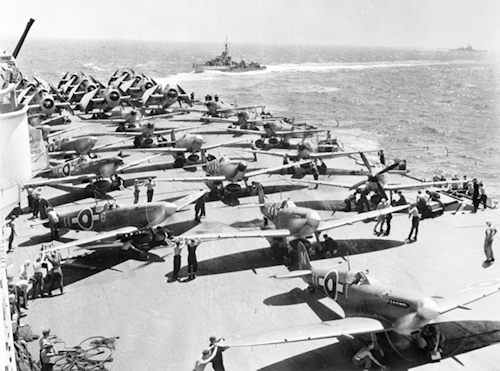The Supermarine Spitfire ("Sputafuoco") was one of the most important fighters of the Second World War and was, in its own right, an icon and flagship of the Fighter Command of the British Royal Air Force. Numerous versions and subversions were made.
For the realization of the Spitfire the technicians were inspired by the Supermarine S.6B which in 1931 had won the Schneider Cup setting a new record: Lt. George Hedley Stainforth with the Supermarine S.6B was able to reach a speed of almost 656 km/h, with a maximum peak of 688,20 km/h.
Lo Spitfire it was designed by Reginald Mitchell; the first prototype took off on March 5, 1936 and was piloted by Captain Joseph "Mutt" Summers.
The aircraft immediately obtained good results: it was able to exceed 500 km/h. The leaders of the Royal Air Force were impressed, so the Air Ministry decided to order a first batch of 310 aircraft from Supermarine Aviation Works.
Subsequently the orders became so large that, when the United Kingdom entered the war on 3 September 1939 (the Spitfire entered service in 1938), the total demand amounted to more than 2100 examples. However, deliveries were not as fast.

Between 1939 and 1945 it Spitfire it had extraordinary improvements, while maintaining its basic structure unchanged. According to the technicians of the time “it was an aircraft of extremely rare constructive balance. Extremely manoeuvrable, thanks to its unprecedented elliptical wing, flawless from an aeronautical point of view and a phenomenal fighting machine " (however in the sinks at maximum speed there was a bending of the tail during the recall, which led to a catastrophic inversion of the commands..., ed).
During the war the aircraft was used by the air forces of numerous allied countries (including Australia, the Soviet Union and the United States).
In total, more than 1938 were built between 1948 and 20.000. Spitfire. It should be noted that the Supermarine derives from the latter Spiteful, the Supermarine Seafire (next photo) and the Supermarine Seafang.
Present in all skies during the war, the popularity of Spitfire will forever be linked to Battle of England (July-October 1940).
It is good to remember that at that time the Fighter Command of the Royal Air Force – under the orders of theair chief marshal Hugh Dowding – also had fighter jets at his disposal Hawker Hurricane e Boulton Paul P.82 Defiant. The latter turned out to be completely unsuitable for combat.
Finally, in the Battle of England they were the Spitfire together with Hurricane to defend the territory from attacks by the Luftwaffe.

In addition to the Royal Air Force fighters, the Luftwaffe offensive had to deal with another exceptional obstacle: the anti-aircraft guns assigned to the defense of British territory. These were pieces that "like those that had been supplied to the French expeditionary force, while continuing to belong to the army that made them available, operationally they depended on the RAF fighter command".1 Although in the course of battle of england these guns shot down a relatively small number of German bombers, their work helped considerably to increase the tension of the attackers, mainly affecting their accuracy in the bombing phase.
From July to October 1940 the German air attacks caused very serious damage and destruction, and their effects would have been even more serious if the Germans had persisted in repeatedly attacking the main British industrial centres. But the Luftwaffe completely missed its primary strategic objective: to destroy Royal Air Force fighters and weaken British morale. The UK had won!
During the battle of england the Luftwaffe lost 1733 aircraft, while the Royal Air Force 915 fighters. While not without single losses in dogfights, the Spitfire he imposed in all the theaters of war an indisputable tactical superiority over each of the many adversaries he gradually encountered.
Giorgio Bonacina writes: “They were, by definition, pure fighters, just as good in interception and escort duties, but they proved excellent as well as assault aircraft – in North Africa and in France in 1944, above all – and how fighter-bombers”.2
 - Spitfire, thanks to the acuity of their construction formula, they served the Royal Air Force excellently in all theatres.
- Spitfire, thanks to the acuity of their construction formula, they served the Royal Air Force excellently in all theatres.
No one gave them a more deserved and heartfelt commendation than that of Colonel Adolf Galland (in the photo, right) - German aviation ace - who, when asked by Hermann Goering about what more was needed to better conduct the Battle of England, He answered: "One squadron of Spitfires, sir marshal!".
After the war it was still used for a long time by the air forces of many nations, including Italy; it was permanently decommissioned in 1961 (Irish Air Corps).
Lo Spitfire it had a wingspan of 11,23 m, length 9,12 m and height of 3,48 m.
The empty weight was 2297 kg, while loaded was 3004 kg.
Motor: 1 Rolls-Royce Merlin 45, power 1470 HP. The maximum speed was about 600 km/h and the service ceiling was over 11.000 m.
The armament consisted of machine guns Browning 7,7mm, cannons Hispano Mk.II 20 mm and 2 RP-3 rockets (1 under each wing).
1 BH Liddell Hart, Military history of World War II. Armies, fronts and battles, Mondadori, Milan, 2021, p.131
2 See G. Bonacina, The Spitfire, in Illustrated History n°145, 1969, p.124












